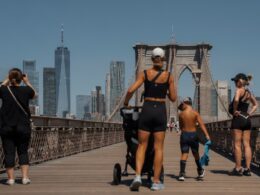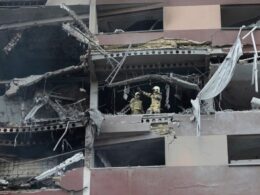Zohran Mamdani’s projected victory in Tuesday’s Democratic mayoral primary was propelled by a surge in voters from historically Black and Hispanic neighborhoods coming out to support him despite leaning more moderate in past elections, including backing Eric Adams in 2021, according to a Daily News analysis of ballot data.
Two key factors appear to be at play.
Many voters in those neighborhoods appear to have been drawn in by Mamdani’s theme of affordability amidst growing economic uncertainty, experts say. The makeup of the neighborhoods themselves have also changed, with gentrification driving an influx of many of the younger, progressive voters that flocked to Mamdani.
Mamdani’s upset win hasn’t been officially declared yet, as ranked choice rounds still need to be added to the mix. But his main opponent, ex-Gov. Andrew Cuomo, condeded the race Tuesday night after it became clear there was no path for him left in the race.
A big reason Cuomo, a centrist, was left without a path is because Mamdani, a socialist, beat him handily in at least seven Assembly Districs that have traditionally had more moderate political sensibilities.
In the 2021 mayoral election, the neighborhoods in question, from Manhattan’s Inwood to Brooklyn’s Bedford-Stuyvesant, went for Adams, a moderate Democrat who ran a succesful campaign that year centered on a law-and-order message. Throughout the 2025 primary campaign, Cuomo tried to appeal to Adams’ base, as the incumbent dropped out of the race amid fallout from his corruption indictment.
For those districts to back Mamdani, a democratic socialist on a tax-the-rich platform, speaks to a shifting current in the city’s electorate. Experts also argued Mamdani was able to make inroads in the areas because Cuomo did little retail politics, leaning instead more on organized labor support and a massive war chest.
These are the seven districts where the Adams-to-Mamdani shift played out in Tuesday’s primary (the tallies are based on unofficial results released by the Board of Elections that include nearly all votes cast):
- Assembly District 42, which spans Flatbush, where Mamdani beat Cuomo by more than 500 ballots
- Assembly District 43, which spans Prospect Lefferts Gardens and Crown Heights, where Mamdani beat Cuomo by 3,800 ballots
- Assembly District 56, which spans Bedford-Stuyvesant, where Mamdani beat Cuomo by more than 10,000 ballots
- Assembly District 68, which spans East Harlem, where Mamdani beat Cuomo by more than 1,100 ballots
- Assembly District 70, which spans Central Harlem and Manhattanville, where Mamdani beat Cuomo by more than 3,800 ballots
- Assembly District 71, which spans Hamilton Heights and Washington Heights, where Mamdani beat Cuomo by more than 5,000 ballots
- Assembly District 72, which spans Washington Heights and Inwood, where Mamdani beat Cuomo by more than 1,400 ballots
Jerry Skurnik, a veteran New York political consultant specializing in voter turnout, said he believes two factors were behind the political shift to Mamdani in those areas.
First, many of the districts have had large influxes of younger, often progressive residents move in as the neighborhoods have gentrified. Many of those residents didn’t vote at all in previous primaries.
“I think younger voters who did not vote either because they weren’t old enough or didn’t care enough [in 2021] came out to vote this year and they voted for Mamdani for the same reason young voters across the city did,” Skurnik said, referencing the excitement that developed during the campaign around Mamdani’s left-wing agenda.
But Skurnik said the data suggests longtime residents of the neighborhoods at hand have shited gears to back Mamdani, too.
He told The News that’s because affordability has become perhaps the most important issue on voters’ minds, as rents remain historically high, while the costs of other essentials, including groceries, have surged as well. Mamdani, in turn, pushed the most aggressive affordability platform in the race, Skurnik argued, pointing to his vows — which critics say are unrealistic — to freeze rent for stabilized tenants, make public buses free and drastically expand subsidized child care.
“The issue of affordability is more important to voters than crime was four years ago,” said Skurnik, referring to Adams’ main 2021 talking point.
Brooklyn Councilman Chi Osse, a progressive Mamdani campaign surrogate whose district overlaps with the 42nd and 56th Assembly Districts, said he believes Cuomo’s Rose Garden-style campaign also hurt his standing in many of the neighborhoods that supported Adams in 2021.
“You had one candidate who was running a rigorous campaign, and on the other you had a former disgraced governor who was hiding from the community,” Osse said Wednesday. “In addition to that, what Zohran did with this campaign is that he spoke to issues that this community really wants, and that’s affordability and fighting against Trump.”
The flip to Mamdani was perhaps most pronounced in Assembly District 56, which includes Adams’ Brooklyn home.
The district, which covers nearly all of Bed-Stuy, went to Adams in 2021 by a somewhat sizable margin, with the mayor clinching 8,974 votes compared to the 6,941 raked in by his closest competitor, Maya Wiley.

By contrast, Mamdani is projected to trounce Cuomo in that district, raking in at least 15,436 ballots compared to the ex-gov’s 5,110, the early returns show.
Similar, but not quite as sweeping of a shift played out in uptown Manhattan, including in Assembly District 71, where Adams eeked out a victory in 2021, pulling in 6,231 votes compared to Wiley’s 6,143.
This time around, Mamdani is on track to beat Cuomo by at least a 5,000-ballot margin.
City Councilwoman Carmen de la Rosa, whose district ovelaps with the 71st, said the jump to Mamdani in her area was largely driven by energized young voters.
“But I also saw older people who traditionally would have voted Cuomo … When I was having that conversation with people, even the older, more traditional base kept saying to me, ‘we need a change, this has not been working for us,’” she said.
Mamdani’s campaign didn’t immediately return a request for comment Wednesday on the turnout trends.

Though Mamdani’s campaign team was ecstatic Tuesday night, there’s a long road ahead to November’s general election.
Adams will run in the November contest as an independent, as will lawyer Jim Walden. Republican Curtis Sliwa will also be on the ballot, and Cuomo hasn’t ruled out running as an independent in November, too.
In interview on “Fox & Friends” on Wednesday, Adams provided a taste of how he plans to campaign against Mamdani, arguing the key planks in his platform are impossible to achieve.
“He’s a snake oil salesman,” Adams said. “He will say and do anything to get elected.”








